CUISINE: An Innovative Approach for the Study of Culinary Practices in Past Societies
The aim of this two-year project (2017-19) is to develop an innovative methodology for the study of culinary practices (cuisine) in past societies integrating the morpho-typological analysis of cooking pots, the analysis of their lipid content and the analysis of microbotanical remains (phytoliths and starch grains). In order to interpret the archaeological record, extensive plant reference collections and several experiments will be developed as part of the project. At the same time, the methods developed during the experimentation phase will be applied to two archaeological case studies in the Aegean, an area that has historically been (and still is) a crossroad for people and foodstuffs: the Neolithic site of Stavroupoli (Greek Macedonia, ca. 5600-5000 cal. BC) and the Bronze Age site of Knossos-Gypsades (Minoan Crete, ca. 1700-1100 cal. BC). The development of these integrated analyses on Neolithic and Bronze Age settlements will allow for the study of the emergence of new social practices and cultural identities linked to the origins of food production and the development of complex, urban societies.
Experimentation is an essential part of this project in order a) to test the feasibility of the integrated analysis of microbotanical remains and lipids from cooking pottery, b) to address preservation and representativeness issues and c) to develop novel methodologies for the integrated analysis of microbotanical remains and lipids.
The project is highly innovative both theoretically and methodologically. From a theoretical perspective, it brings plants into the picture on the basis of full-spectrum residue analyses from archaeological pottery. Plants and animals are often cooked (and consumed) together (e.g. the combination of dairy and cereals to prepare dishes such as trahanas, the use of spices to flavour up a stew, etc.). However, the analysis of lipids absorbed in archaeological pottery appears to favour animal ingredients when studying past culinary practices, whereas the identification of cereals and pulses, which likely formed the basis of the human diet from the Neolithic onwards, has proved to be more elusive. Thus, the combination of techniques/approaches proposed in this project will eliminate the methodological bias that has overemphasised the role of meat products and by-products on prehistoric cuisine. Furthermore, earlier archaeobotanical and zooarchaeological research in Greece has provided the list of foodstuffs consumed by prehistoric communities. However, macrobotanical and faunal remains are seldom associated with the artefact in which they were cooked, and therefore we know the list of foodstuffs but not what ingredients were cooked together, how were they cooked, etc. By focusing on remains recovered from the actual cooking utensils, this project will be able to explore the culinary practices of past communities.
From a methodological perspective, the recovery of lipids and microbotanical remains from a single sample and in a single procedure would greatly advance the study of past culinary practices, with huge potential implications for future integrated analyses of these complementary proxies. If successful, this novel recovery method would not require the preservation of food crust or the storage of unwashed potsherds, and potentially any archaeological sherd could be analysed, regardless of when or how it was excavated/stored.
Principal investigator: Juan José García-Granero
Scientists in charge and senior collaborators: Amy Bogaard (University of Oxford), Dushka Urem-Kotsou (Democritus University of Thrace), Eleni Hatzaki (University of Cincinnati), Stavros Kotsos (Ephorate of Antiquities of Thessaloniki City), Valasia Isaakidou (University of Oxford), Costanza Dal Cin D'Agata (Technical University of Crete)
Project collaborators: Evgenia Tsafou (Université Catholique de Louvain), Marianna Lymperaki (Democritus University of Thrace), Marc Càrdenas (Basque Culinary Centre)
Project sponsor: European Commission (Marie-Skłodowska-Curie Actions 2015)
Experimental cooking
Mr. Yannis Staggidis, an experienced traditional potter based at Paliambela (Central Macedonia, Greece), has produced modern replica vessels imitating the technological and morphological traits of northern Greek Neolithic cooking vessels. These replica vessels will be used to carry out a series of cooking experiments to study:
a) the preservation of microbotanical remains when cooked with different vessels and cooking conditions (technique, temperature, time, etc.), following earlier experiments but focusing also on taxa beyond cereals and pulses, including meat and dairy products;
b) the spatial distribution of microbotanical remains in pottery vessels, following work carried out within lipid residue studies; and
c) the relative occurrence of microbotanical remains from different taxa after successive cooking experiments.
Samples from past cooking experiments conducted by Prof. Dushka Urem-Kotsou with cereals and pulses consumed in the prehistoric Aegean are currently being analysed as a pilot study to inform the design of future cooking experiments.
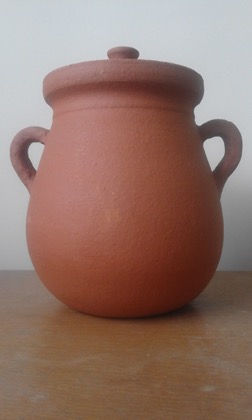
Modern replica cooking vessel produced by Mr. Yannis Staggidis.

Laboratory experimentation
Laboratory experiments will be carried out with subsamples of the replica vessels to develop a method to recover lipids and microbotanical remains from a single sample and in a single procedure. At present, these proxies are seldom analysed as part of the same study, and when analysed they come from different vessels, thus impeding an effective integration of the results. The experiments will aim at designing a procedure in which all proxies can be independently extracted from a single vessel and, ideally, from a single original sample. The experiments will be specifically directed towards recovering microbotanical remains from the powder resulting from the pottery drilling method used to extract lipids, which is collected from the innermost part of the potsherd to avoid contamination from modern sources.
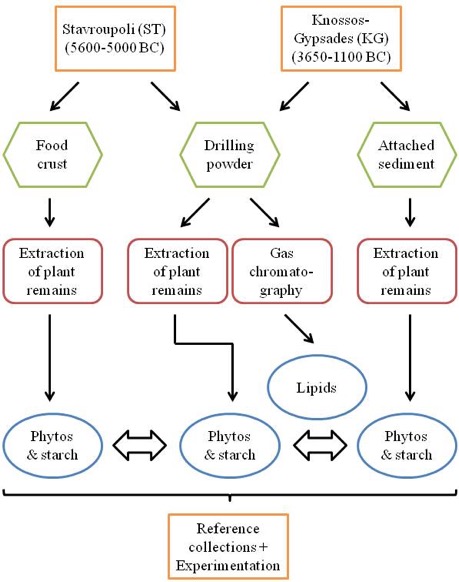
The microbotanical remains recovered using traditional methods (sampling of food crust/attached sediment) will be compared with the remains recovered using the experimentally developed method (pottery powder), thus independently assessing the validity of the new method against two standard procedures.

Reference collection
A modern plant reference collection will be created to identify plant proxies in cooking pottery. The design of the reference collection will be based on literature data on traditional culinary practices and archaeological plant assemblages from both areas of study (northern Greece and Crete). Modern plants will be collected to identify diagnostic microbotanical remains as well as their lipid content, paying special attention to plants commonly used for cooking but often overlooked in archaeobotanical research, such as spices, wild greens (horta) and oily plants.
The microbotanical and lipid reference collections will be developed from the extensive modern plant reference collections hosted at the Archaeobotany Laboratory, School of Archaeology, University of Oxford. Moreover, last summer we visited the Park for the Preservation of Flora and Fauna, Technical University of Crete (Hania, Crete). While visiting the Park and its herbarium with Costanza Dal Cin D’Agata, the Park leading botanist, we had the opportunity to sample certain plant species, such as the Cretan date palm (Phoenix theophrasti Greuter), a species endemic to the island (and few other locations along the eastern Mediterranean shores) which, according to iconographic studies, could have been used in Minoan times. Furthermore, we visited Vai beach (Lasithi, Crete) to sample more Cretan date palm specimens at Europe’s biggest palm forest. The work at the Park for the Preservation of Flora and Fauna and other locations around Crete will continue in July 2017.
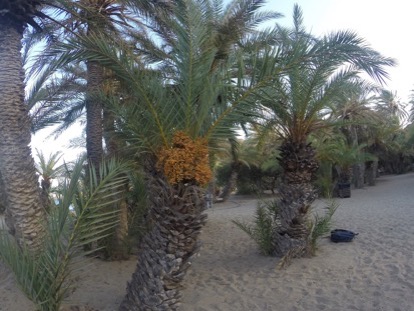
Cretan palm (Phoenix theophrasti Greuter) forest, Vai beach, Crete.
Neolithic Stavroupoli
Stavroupoli is a multi-phase flat-extended site located on a natural low hill in the modern town of Thessaloniki. Ongoing excavations revealed deposits dated to the Middle (Stavroupoli Ia) and early Late Neolithic (Stavroupoli I), which covered the period between 5890 and 5531 cal. BC, according to radiocarbon dates. Pottery indicates, however, that the settlement was inhabited during the whole period of the early Late Neolithic (5400-5000 cal. BC). The last habitation phase (Stavroupoli II) dates to the later phase of the Late Neolithic (5000-4500 cal. BC) or to the Final Neolithic (4500-3300 cal. BC), according to pottery typology. The total extent of the site reaches approximately 11.2 ha, but it appears it was never inhabited across its total extent at the same time. The samples analysed in this study come from the Stavroupoli I phase. In this phase the settlement was surrounded by a ditch and occupied an area of at least 8 ha. The houses had a rectangular plan and plastered floors, and ovens and hearths were located both inside and outside the houses, implying cooking in private and in public.
A total of 37 cooking pots from late Middle Neolithic and the early Late Neolithic Stavroupoli (ca. 5600–5000 cal. BC) presented charred food crusts adhered to the inner walls of the vessels, which have been sampled for microbotanical analyses. The samples analysed in this study come from two different areas of the settlement, 50 m distant from one another: deposits located at Gorgopotamou Street and deposits located at Koromila Street. In each area, remains of at least two houses were found.
First results
A pilot microbotanical study of the charred food crust from 17 cooking pots showed that the food represented by burnt remains included domestic wheat(s) and lentils, as well as weedy Setaria sp. and other wild plants. The presence of Setaria weeds suggests high soil fertility and disturbed growing conditions. These results further indicate that the inhabitants of different areas of the settlement had differential access to food resources (more vs. less valued food), which might be related to a) different types of meals being prepared in separated areas of the site, or b) different preferences or economic status of its inhabitants expressed through culinary practices. At present, we lack enough evidence to favour one hypothesis over the others. Future research at Stavroupoli will specifically target this issue through integrated microbotanical and lipid analyses from cooking vessels from different areas of the site.
To find out more
Grammenos DB, Kotsos S (eds) (2002) Rescue excavations at the Neolithic Site of Stavroupoli Thessaloniki. Archaeological Institute of Northern Greece, Thessaloniki
Grammenos DB, Kotsos S (eds) (2004) Rescue excavations at the Neolithic Site of Stavroupoli Thessaloniki. Part II (1998–2003). Archaeological Institute of Northern Greece, Thessaloniki
Kotsos S (2014) Settlement and housing during the 6th millennium BC in western Thessaloniki and the adjacent Langadas province. In Stefani E et al. (eds) Proceedings, International Conference “1912–2012: a Century of Research in Prehistoric Macedonia”. Archaeological Museum of Thessaloniki, Thessaloniki, pp 315–326
Kotsos S, Urem-Kotsou D (2006) Filling in the Neolithic landscape of central Macedonia, Greece. In Tasic N, Grozdanov C (eds) Homage to Milutin Garasanin. Serbian Academy of Science and Arts, Belgrade, pp 193–207
García-Granero JJ et al. (2017) Cooking plant foods in the northern Aegean: Microbotanical evidence from Neolithic Stavroupoli (Thessaloniki, Greece). Quat Int. doi: 10.1016/j.quaint.2017.04.007
Lymperaki M et al. (2016) Household scales: what cooking pots can tell us about households in the Late Neolithic Stavroupoli (Northern Greece). Open Archaeol 2, 328–345
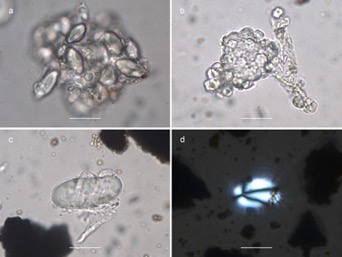
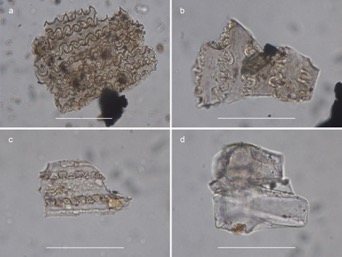
Starch grains and phytoliths from food crust samples from Stavroupoli.

Bronze Age Knossos-Gypsades
Knossos-Gypsades is a Middle Bronze Age (ca. 1700-1100 cal. BC) Knossian 'neighbourhood' located between the palace to the north and the cemetery area to the south. It is currently being studied as part of a synergasia between the Herakleion Ephoreia and the British School at Athens, directed by Ioanna Sepretsidaki (Herakleion Ephoreia), Eleni Hatzaki (University of Cincinnati), Amy Bogaard (University of Oxford) and Gianna Ayala (University of Sheffield) under the auspices of the British School at Athens.
Aim and methods
As part of the intensive recording of material culture and systematic sampling of bioarchaeological proxies implemented at Knossos-Gypsades, cooking vessels and other types of potsherds were carefully collected and sampled in order to explore food and drink consumption patterns in Minoan Knossos. The sampling of microbotanical remains consisted of a two-step process in which the outer layer of sediment was first dry brushed from the inner surface of the potsherd (dry sample), and then the inner layer of sediment was brushed with distilled water (wet sample). Sampling for lipid analyses will happen in the near future.
First results
We are currently working on the microbotanical samples from Knossos-Gypsades
To find out more
Hogarth DG (1900) Knossos: II. Early Town and Cemeteries. BSA 6, 70–84
Hood MSF (1962) Stratigraphic excavations at Knossos, 1957-61. Kretika Chronika (Pepragmena tou A ’Diethnous Kretologikou Synedriou)15–16, 92–97
Morgan C (2015) The work of the British School at Athens, 2014–2015. Archaeological Reports 61, 34-48
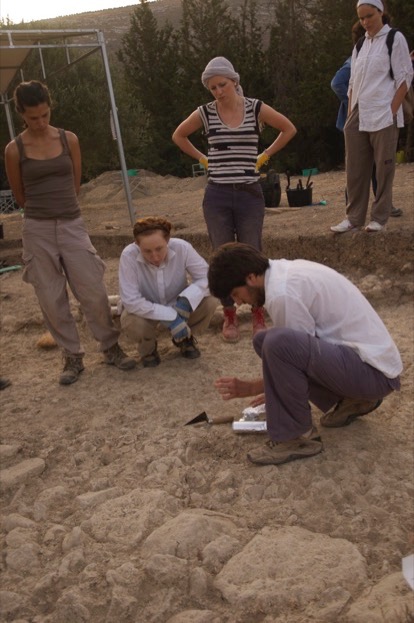
Recovering cooking vessels during the 2014 field season at Knossos-Gypsades.

Marc Cardenas collecting a wet sample from a Minoan potsherd from Knossos-Gypsades
at the Stratigraphic Museum (Knossos, Crete) in 2016.

Project outcomes
Conferences and talks
Poster presentation. García-Granero JJ, Urem-Kotsou D, Bogaard A, Kotsos S, Hatzaki E. The CUISINE project: an innovative approach for the study of culinary practices in past societies. 17th Conference of the International Work Group for Palaeoethnobotany, Paris (France), 4–9 July 2016
Seminar. García-Granero JJ. The CUISINE project: exploring past culinary practices through integrated microbotanical and lipid analyses. Archaeobotany Discussion Group, Institute of Archaeology, University of Oxford (UK), 5 June 2017
Seminar. García-Granero JJ. Developing innovative approaches to past culinary practices. Bioarchaeology Seminars, Research Laboratory for Archaeology and the History of Art, University of Oxford (UK), 22 June 2017
Oral presentation. García-Granero JJ, Bogaard A, Urem-Kotsou D, Tsafou E, Kotsos S, Hatzaki E. Exploring Greek prehistoric cuisine through phytolith and starch analyses. 4th Symposium of Greek Gastronomy, Hania (Greece), 29–30 July 2017
Oral presentation. García-Granero JJ, Hatzaki E, Tsafou E, Cárdenas M, Ayala G, Bogaard A. Exploring foodways in a Late Minoan Knossian ‘neighbourhood’ (Gypsades, Crete) through microbotanical analyses. 24th Annual Meeting of the European Association of Archaeologists, Barcelona (Spain), 5–8 September 2018.
Oral presentation. García-Granero JJ, Urem-Kotsou D, Lymperaki M, Stagkidis Y, Bogaard A. The truth lies within the pot: experimental approaches to the reconstruction of prehistoric culinary practices through microbotanical analyses. 24th Annual Meeting of the European Association of Archaeologists, Barcelona (Spain), 5–8 September 2018.
Publications
García-Granero JJ, Urem-Kotsou D, Bogaard A, Kotsos S (2017) Cooking plant foods in the northern Aegean: Microbotanical evidence from Neolithic Stavroupoli (Thessaloniki, Greece). Quat Int. doi: 10.1016/j.quaint.2017.04.007
García-Granero JJ, Sarpaki A, Skoula M, Cárdenas M, Madella M, Bogaard A (under review) Unravelling the cultural trajectory of Phoenix theophrasti Greuter (Cretan date palm): an ethnobotanical and archaeobotanical approach to a neglected palm. Journal of Ethnobiology.
References
Andreou S et al. (2001) Review of Aegean prehistory V: the Neolithic and Bronze Age of northern Greece. In Cullen T (ed) Aegean Pre-history: A Review. Archaeological Institute of America, Boston, pp 259–327
Craig O et al. (2005) Did the first farmers of central and eastern Europe produce dairy foods? Antiquity 79, 882–894
Evershed RP (2008) Experimental approaches to the interpretation of absorbed organic residues in archaeological ceramics. World Archaeol 40, 26–47
Evershed RP et al. (1991) Epicuticular wax components preserved in potsherds as chemical indicators of leafy vegetables in ancient diets. Antiquity 65, 540–544
Evershed RP et al. (1994) Application of isotope ratio monitoring gas chromatography-mass spectrometry to the analysis of organic residues of archaeological origin. Analyst 119, 909–914
Evershed RP et al. (2008) Earliest date of milk use in the Near East and southeastern Europe linked to cattle herding. Nature 455, 528–531
Hart TC (2011) Evaluating the usefulness of phytoliths and starch grains found on survey artifacts. J Archaeol Sci 38, 3244–3253
Halstead P (2015) Feast, food and fodder in Neolithic-Bronze Age Greece: commensality and the construction of value. In Pollock S (ed) Between Feasts and Daily Meals. Topoi, Berlin, pp 29–61
Halstead P, Barrett JC (eds) (2005) Food, cuisine and society in prehistoric Greece. Oxbow books, Oxford
Henry A et al. (2009) Changes in starch grain morphologies from cooking. J Archaeol Sci 36, 915–922
Isaakidou V (2007) Cooking up the Labyrinth: exploring 'cuisine' at Bronze Age Knossos. In Renard J, Mee C (eds) Cooking up the Past: Food and Culinary Practices in the Neolithic and Bronze Aegean. Oxbow Books, Oxford, pp 5–24
Livarda A, Kotzamani G (2013) The archaeobotany of Neolithic and Bronze Age Crete: synthesis and prospects. Ann Brit Sch Athens 108, 1–29
Mitkidou et al. (2008) Organic residue analysis of Neolithic pottery from North Greece. Microchemica Acta 160, 493–498
Piperno DR (2006) Phytoliths: a comprehensive guide for archaeologists and paleoecologists. Altamira Press, Lanham
Saul H et al. (2012) A systematic approach to the recovery and identification of starches from carbonised deposits on ceramic vessels. J Archaeol Sci 39, 3483–3492
Saul H et al. (2013) Phytoliths in pottery reveal the use of spice in European prehistoric cuisine. PLoS ONE 8, e70583
Torrence R, Barton H (eds) Ancient starch research. Left Coast Press, Walnut Creek
Urem-Kotsou D (2011) Recent approaches in ceramic research. Vessel use and food residue analysis in Late Neolithic pottery from northern Greece. In Panonski Prapovijesni Osviti: Zbornik Radova Posve cen Korneliji Minichreiter, uz 65. Obljetnicu Zivota. Institut za Arheologiju, Zagreb, pp 247–265
Urem-Kotsou D, Kotsakis K (2007) Pottery, cuisine and community in the Neolithic of north Greece. In Mee C, Renard J (eds) Cooking up the Past: Food and Culinary Practices in the Neolithic and Bronze Age Aegean. Oxbow, Oxford, pp 225–246
Valamoti SM (2004) Plants and People in Late Neolithic and Early Bronze Age Northern Greece: an Archaeobotanical Investigation. Archaeopress, Oxford
Valamoti SM et al. (2008) Prehistoric cereal foods from Greece and Bulgaria: investigation of starch microstructure in experi- mental and archaeological charred remains. Veg Hist Archaeobot 17, S265–S276
Valamoti SM et al. (2011) An investigation of processing and consumption of pulses among prehistoric societies: archaeobotanical, experimental and ethnographic evidence from Greece. Veg Hist Archaeobot 20, 381–396






